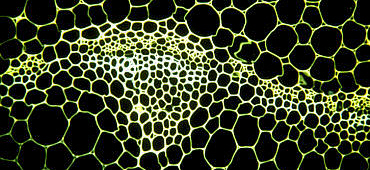
The collateral open vascular bundles of dicots display xylem and phloem that are separated from each other by the fascicular cambium. These vascular bundles are also often surrounded by a bundle sheath and the whole structure is imbedded in a parenchyma tissue called pith. Another type of vascular bundles are the bicollateral bundles. Vascular bundle and interfascicular cambium (Ajuga reptans)
For reasons of simplicity, the organization of primary vascular bundles in the shoots of herbaceous plants is discussed first. The prime object of botanical courses for this topic is Ranunculus repens , that belongs to the buttercup-family. The vascular bundles of herbaceous plants are termed collateral and open, because xylem and phloem are opposed and separated by a fascicular cambium of usually several layers thickness. There are exceptions from this organization: collateral open vascular bundles exist also in dicots, some monocots have collateral closed and some gymnosperms collateral open bundles.
The circular arrangement of vascular bundles can be observed very well in cross-sections of the stem. Interfascicular cambium occurs in many, but not all species (for example the mentioned Ranunculus repens). Herbaceous dicots do always have a fascicular cambium, that is, however, usually not divided any more.
The structural elements of xylem and phloem are the same as in
monocots. The vascular bundles are often enclosed by a bundle sheath
of cells with thickened walls and are embedded in a parenchyma of
large cells, the pith. Parenchyma areas between the bundles are often
called ray parenchyma. Deviations
of this organization are found in square stems, where the arrangement
of the vascular bundles and the shape of the cross-section are in
tune with each other. 
A largely changed pattern appears in some families (Solanaceae, Asclepidaceae, Compositae, Curcubitaceae and others), whose vascular bundles are open and bicollateral, i.e. the xylem is on both sides associated with phloem. The vascular bundles are arranged in two concentric circles, the lumina of the inner circle being much wider than those of the outer.
Aristolochia sipho has proven
useful for the demonstration of secondary growth and thus also for
the development of wood. Very young branches have merely any
fascicular cambium. Interfascicular cambium develops very early
during the first year even before the beginning of secondary growth.
This pattern is largely kept in branches of several years' age. The
activity of the cambium increases their diameter and the vascular
bundles become elongated in cross-section. In general, far more xylem
than phloem elements are produced. Annual rings are clearly visible,
because at the beginning of each vegetation period (in spring),
vessels (conducting function) and fibres (supporting function) with a
wide lumen are assembled first, the so-called
early wood. In the following,
elements with steadily narrowing volumes are produced. In autumn,
only few vascular elements with narrow lumina
(late wood) form.
|
|